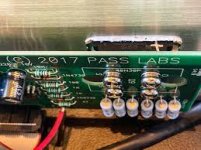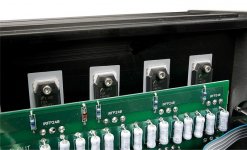ClassA? Why? World is moving to classD and surface mount...
Class D is more about energy efficiency. Sound is not important anymore. Long story short, most of the time it's just an over-engineered, over-complicated cr*p especially in high power professional amps ! Huge e-waste.
Good luck with more than 10 watts of average power dissipation from a surface mount package. I’ll take a TO-247 if I can get it.Kidding aside, the correlation between mosfet packaging and sound quality is purely fictional.
For single ended class A, IRFP240 / IRFP9240 or FQA27N25 / FQA36P15.
Of course and we don't have much choice anymore.I’ll take a TO-247 if I can get it.
But some noobs here believe in the 'magical' acoustics of TO-220 mosfets 🤣 🤣 🤣
I know, right?!Class D is more about energy efficiency. Sound is not important anymore. Long story short, most of the time it's just an over-engineered, over-complicated cr*p especially in high power professional amps ! Huge e-waste.
It's like typical class-b/ab taken to the next level, without considering the fundamentals. Just about every damn speaker datasheet ever made, which at least has T-S parameters, specifies motor strength in newtons per ampere, yet nearly everyone designs amplifiers with voltage as the controlled variable instead of current. It's not like 99.99% of speakers out there are electrostatics? I give up!
For class D to be done right, I'd have to start from scratch with a MOSFET H-bridge and a custom switching scheme that regulates the current passing through, on top of all the other stuff like making the switching noise ultrasonic.
Throw-away "smart" phones even have thermal sensing so they can run the built-in speakers a lot harder without blowing them up. Yet for some reason the "hifi" world somehow has to wait for all the best tech to trickle down to the high end LOL.
It should be do-able, though. Air-cored output chokes could also make a difference.
The magical acoustics of TO-220 mosfets come from the sound of a fan running. 😀
That would make DPAKs and SOT323’s even better since the fan would need to be aimed right at the PCB to keep it from attaining temps approaching the surface of the sun.
That would make DPAKs and SOT323’s even better since the fan would need to be aimed right at the PCB to keep it from attaining temps approaching the surface of the sun.
As for MOSFETs, the Exicons are still available, right?
Cree, Rohm, and a couple of other manufacturers produce silicon carbide 'SiC' FETs, which seem promising due to claimed robustness in linear applications. Most vertical MOSFETs seem to have a bit of thermal runaway, where, as they get hotter Vgs reduces and causes more current to flow. The high equilibrium point could favour class-a with an extremely high bias current, but it was meant for fast switching.
Also, SiC JFETs...
Cree, Rohm, and a couple of other manufacturers produce silicon carbide 'SiC' FETs, which seem promising due to claimed robustness in linear applications. Most vertical MOSFETs seem to have a bit of thermal runaway, where, as they get hotter Vgs reduces and causes more current to flow. The high equilibrium point could favour class-a with an extremely high bias current, but it was meant for fast switching.
Also, SiC JFETs...
IRF540/9540 and IRF540N/9540N are my favourites.
That is if I should believe my SPICE.
They are TO-220 which make heatsinking very easy.
That is if I should believe my SPICE.
They are TO-220 which make heatsinking very easy.
Limit it to about 200, maybe 400 watts, requiring only one quad of mosfets. And can have a low enough Qg that you can get away with 5 nanoseconds of dead time. THEN class D approaches the best class AB (or even A) sound. IF you get all the EMI under control. Big if.For class D to be done right, I'd have to start from scratch with a MOSFET H-bridge and a custom switching scheme that regulates the current passing through, on top of all the other stuff like making the switching noise ultrasonic.
When you scale things up in those big pro amps, the size of the output stage is no longer electrically small, and you have to do things that compromise the sound (translation: cause timing errors) just to make it reliable. Some of the cheap stuff just uses a reference design from IR and does very little refinement. Even worse.
TO-220’s are easy to heat sink if the average power dissipation per package is on the order of 20 watts. 40 is iffy without fans, and fuggettabouttit if you need 80. Case to sink resistance is a big choke.IRF540/9540 and IRF540N/9540N are my favourites.
That is if I should believe my SPICE.
They are TO-220 which make heatsinking very easy.
;-)
There is a chance for TO-247 e.g.: you could cut the cases;-) The colors will be much cleaner, radiant. The grain finer. A veil will be pulled away. But it will not sound more vivid. Nor more concentrated, not to the point.
Something for noobs in an diy-AUDIO (audire: hear, listen) forum;-) Nothing for people who like to look at... whatever;-)
There is a chance for TO-247 e.g.: you could cut the cases;-) The colors will be much cleaner, radiant. The grain finer. A veil will be pulled away. But it will not sound more vivid. Nor more concentrated, not to the point.
Something for noobs in an diy-AUDIO (audire: hear, listen) forum;-) Nothing for people who like to look at... whatever;-)
”Warm” sound - “sounds more like a tube” if you put your finger on the case and it leaves a mark. 😀
Not to mention electrical isolation. One trick is to use an intermediate layer of copper that is much larger than the case but is directly connected, and the electrical insulation goes between the copper and the alu heat sink. The insulator bottleneck is significantly improved, at the cost of a few extra pF from the larger surface area.TO-220’s are easy to heat sink if the average power dissipation per package is on the order of 20 watts. 40 is iffy without fans, and fuggettabouttit if you need 80. Case to sink resistance is a big choke.
Use a wood chassis, do not ground the heatsink and use drain outputs. For example, mount IRF9520 and IRF510 to the same heatsink without insulation, this is diy!
Thanks for posting that. That's a unusual type of vas (current mirror with gain) that I never built or simulated.
Class D is so easy with clarity and reliabilityClass D is more about energy efficiency. Sound is not important anymore. Long story short, most of the time it's just an over-engineered, over-complicated cr*p especially in high power professional amps ! Huge e-waste.
Best output MOSFETs for 2023? Who knows what February to December would bring.I am trying to pick a MOSFET to use in a Class A design.
...unfortunately. Check out the character of residual distortion (fundamental notched out) in the stereophile reviews of commercial power amps in Class-A and Class-D and you will understand, why I think so.ClassA? Why? World is moving to classD and surface mount...
A lot of commercial amp models use custom made versions - not listed by mouser etc - e.g. SANKEN's MLE20 - go toI am trying to pick a MOSFET to use in a Class A design. Most of the recommendations I have found thus far on the forum are considered obsolete by vendors. What do you prefer that is still available?
https://www.diyaudio.com/community/threads/yamahas-new-floating-and-balanced-power-amplifier.290584/
Mr. Nelson Pass seems to be prefer still the use of good available MOSFET versions from trusted brands - go to
https://www.moremusic.nl/reviews/passlabs/INT-25/review-PassLabs-INT-25-Stereo.pdf
and the attached images.
He can certainly give you the best recommendations on which MOSFET's and which brands to prefer.
Attachments
- Home
- Amplifiers
- Solid State
- Best output MOSFETs for 2023

